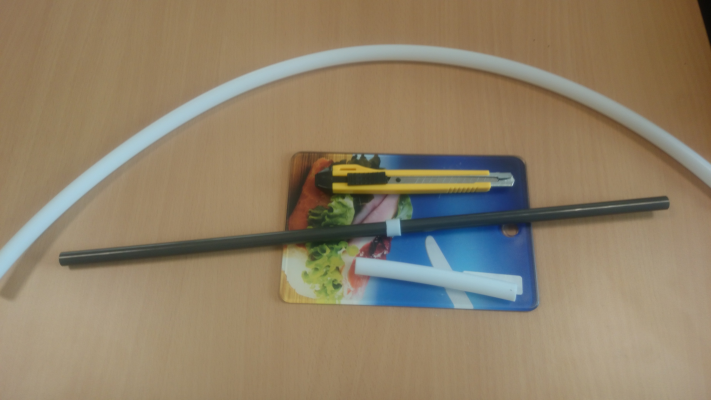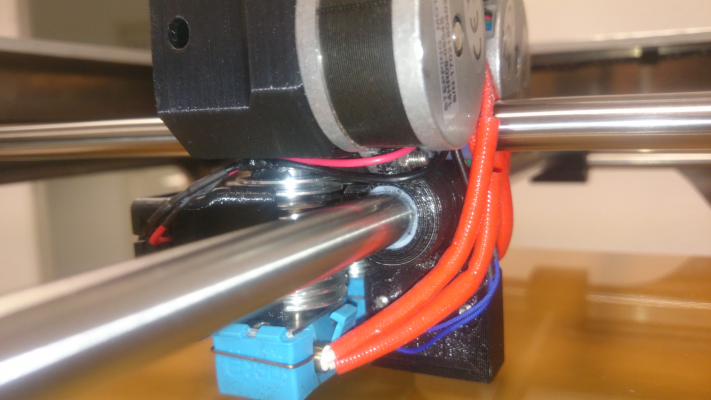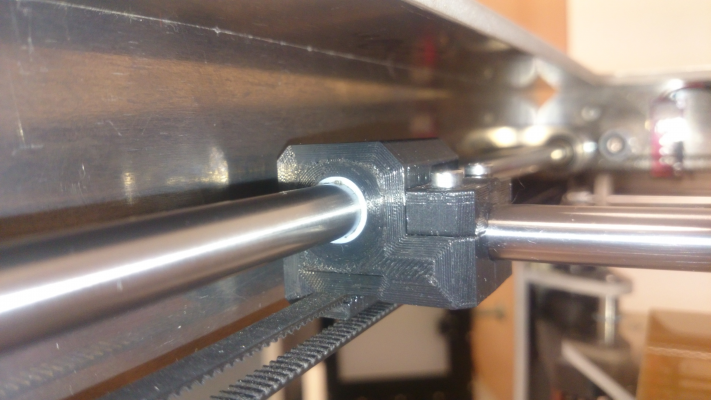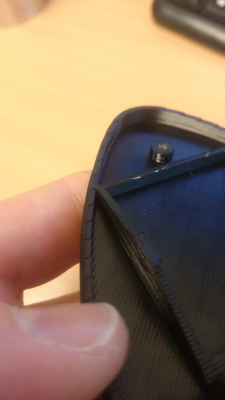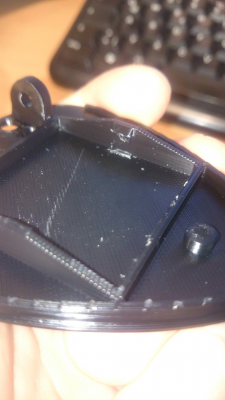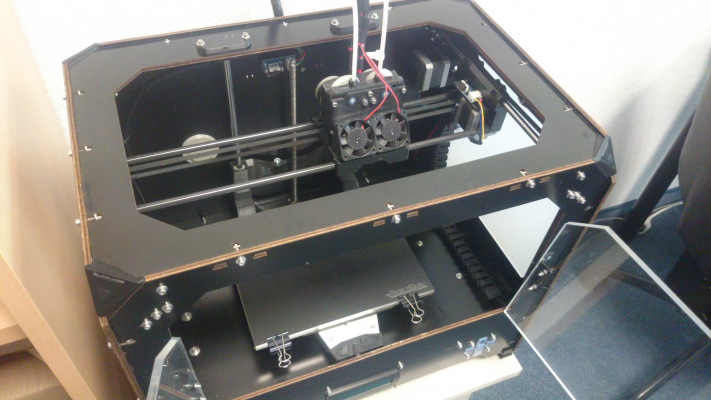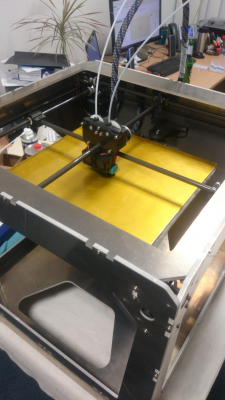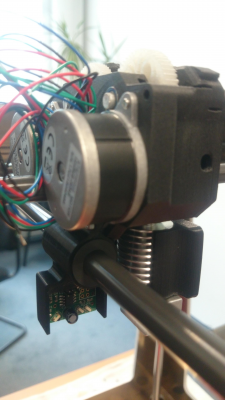Cheap and easy high performance self-made bushing alternative
Posted by jerryjs8
|
Cheap and easy high performance self-made bushing alternative February 07, 2018 05:03AM |
Registered: 6 years ago Posts: 50 |
So while building my printer I went through a lot of trying out different combinations of bushings and rod materials. Aluminium and steel rods, IGUS to sinzer bronze bushings, nothing really worked well. I've seen some constructions with several small diameter PTFE tubes in a printed bushing housing, but I simply bought a meter of large diameter tubing and haven't found a better alternative.
How I made the Teflon bushings
PTFE tubing 10mm I.D. 12mm O.D. - cost 4€/meter with free shipping
Will have to see how it works out in the long term, but it's been great for the past 150 hours!
Now if someone else has been using this as an alternative, great! Don't want to steal your thunder. Just thought I'd share one of my eureka moments cause IGUS and sinzer bronze bushings weren't doing it for me otherwise.
Edited 2 time(s). Last edit at 02/07/2018 05:05AM by jerryjs8.
Build Log - DDDE 330x330x300mm Ultimaker
How I made the Teflon bushings
PTFE tubing 10mm I.D. 12mm O.D. - cost 4€/meter with free shipping
Will have to see how it works out in the long term, but it's been great for the past 150 hours!
Now if someone else has been using this as an alternative, great! Don't want to steal your thunder. Just thought I'd share one of my eureka moments cause IGUS and sinzer bronze bushings weren't doing it for me otherwise.
Edited 2 time(s). Last edit at 02/07/2018 05:05AM by jerryjs8.
Build Log - DDDE 330x330x300mm Ultimaker
|
Re: Cheap and easy high performance self-made bushing alternative February 07, 2018 05:27AM |
Registered: 6 years ago Posts: 1,007 |
IGUS bushings or made with filament, sintered bronze or iron work very well. BUT they need to be precisely mounted, and above all, they must be properly aligned otherwise excessive friction and binding will inevitably occur.
Linear ball bearings won't as they will "align" the poorly made flexible frames which are the norm in the hobby 3D printer. The "imported" one are furthemore crappy but at least they allow these machines to run for some time (with screeching noise while biting in the rods )
PTFE has a lower coef of friction than these bushings but a tendency to give and creep under load, thus less friction and bushings will deform to let's say "autoalign". So it is more likely to lead to more play in the long run.
I am using PTFE in tube and sheet form for some bearings purpose but prefer my own IGUS (which in fact contains some sort of PTFE) made bearings for most.
"A comical prototype doesn't mean a dumb idea is possible" (Thunderf00t)
Linear ball bearings won't as they will "align" the poorly made flexible frames which are the norm in the hobby 3D printer. The "imported" one are furthemore crappy but at least they allow these machines to run for some time (with screeching noise while biting in the rods )
PTFE has a lower coef of friction than these bushings but a tendency to give and creep under load, thus less friction and bushings will deform to let's say "autoalign". So it is more likely to lead to more play in the long run.
I am using PTFE in tube and sheet form for some bearings purpose but prefer my own IGUS (which in fact contains some sort of PTFE) made bearings for most.
"A comical prototype doesn't mean a dumb idea is possible" (Thunderf00t)
|
Re: Cheap and easy high performance self-made bushing alternative February 07, 2018 08:32AM |
Registered: 6 years ago Posts: 109 |
Hi,
Thanks for the tip !! I'll see if I can try it myself. I started with printed pla bushings, the trick here is to get the start 'sticktion' as low as possible, furniture polish helps. In my design its not heavily loaded (e3dv6 is light).
I now know why people dont like the linear roller bearings, they stick at the worst possible moment.
Thanks for the tip !! I'll see if I can try it myself. I started with printed pla bushings, the trick here is to get the start 'sticktion' as low as possible, furniture polish helps. In my design its not heavily loaded (e3dv6 is light).
I now know why people dont like the linear roller bearings, they stick at the worst possible moment.
|
Re: Cheap and easy high performance self-made bushing alternative February 07, 2018 08:45AM |
Registered: 6 years ago Posts: 50 |
Quote
orbitalair
Hi,
Thanks for the tip !! I'll see if I can try it myself. I started with printed pla bushings, the trick here is to get the start 'sticktion' as low as possible, furniture polish helps. In my design its not heavily loaded (e3dv6 is light).
I now know why people dont like the linear roller bearings, they stick at the worst possible moment.
"sticktion", I like that term!
Yeah, the teflon tubing is wonderful from going full stop to smooooooth movement.
Build Log - DDDE 330x330x300mm Ultimaker
|
Re: Cheap and easy high performance self-made bushing alternative February 07, 2018 09:55AM |
Registered: 7 years ago Posts: 257 |
|
Re: Cheap and easy high performance self-made bushing alternative February 07, 2018 08:32PM |
Registered: 6 years ago Posts: 109 |
I don't know maybe its the minimalist approach? The look of polished stainless steel rods?
Wheeled bearings themselves are easier, but requires extruded aluminum box tube, or similar to ride on. Or big bulky rod riders using 4 bearings each.
I see my SmartRap Mini build as art in itself, it would look terrible if it looked like a TronXY X1 (which is the same design using Aluminum X bars).
Wheeled bearings themselves are easier, but requires extruded aluminum box tube, or similar to ride on. Or big bulky rod riders using 4 bearings each.
I see my SmartRap Mini build as art in itself, it would look terrible if it looked like a TronXY X1 (which is the same design using Aluminum X bars).
|
Re: Cheap and easy high performance self-made bushing alternative February 08, 2018 02:25AM |
Registered: 6 years ago Posts: 50 |
Aluminum extrusions and wheels are kinda hard to use in an ultimaker style gantry, which is what I have and what I'm using them for 
And if you already have a printer with rods (i3, Makerbot, etc.), then this might help without remodelling the design.
Build Log - DDDE 330x330x300mm Ultimaker

And if you already have a printer with rods (i3, Makerbot, etc.), then this might help without remodelling the design.
Build Log - DDDE 330x330x300mm Ultimaker
|
Re: Cheap and easy high performance self-made bushing alternative February 08, 2018 03:40AM |
Registered: 6 years ago Posts: 1,007 |
Quote
cwaa
I don't understand why people use rods and linear bearing/bushings when you can have wheels with bearings and a much smoother and simpler approach.
People who can properly design, make, adjust have no issue with rods and bushings. In many case it is a very good if not the only choice. Simple, very light (for carriage, we speak in gram when others speak in 100g), silent, no lubrication;
Wheels running on extrusion are bulky, heavy, more fricition and implies use of extrusions. Despite the use of extrusion, not even easy to enclose the machine !
Their main advantage is that they are very tolerant to sloppy assembly, poor alignment and will not seize or grind.
They are a bonus for cheap kit mfg, easy to make, small package, less trouble with users who had bad experience with crappy LM bearings on soft stainless steel rods..
I consider it a poor choice for a 3D printer of regular size but perfect for a wood CNC router for ex.
Edited 1 time(s). Last edit at 02/08/2018 05:14AM by MKSA.
"A comical prototype doesn't mean a dumb idea is possible" (Thunderf00t)
|
Re: Cheap and easy high performance self-made bushing alternative February 08, 2018 10:17AM |
Registered: 7 years ago Posts: 257 |
|
Re: Cheap and easy high performance self-made bushing alternative February 08, 2018 01:26PM |
Registered: 9 years ago Posts: 465 |
No need to be snarky.
Ball bearings are great, but if you're looking at PTFE tubing as a cheap bushing, you're probably looking to spend as little money as possible to get something that works with reasonable tolerance. This will do that and save some dollars. The smooth rod is cheaper than extrusion, and so will also save some dollars. If initial costs were the same, sure. If it were even reasonably comparable, sure. Smooth rod is half or less the price of 20mm extrusion. This is 4 euro/meter. A typical bushing might be 25mm in length, so that's about 40 bushings, or 0.10 euro per bushing. It's probably about 2-3 euro per ball bearing wheel. (Looking at a few suppliers and a quick currency conversion.) There's quite a bit of money to be saved for new design, and even more to be saved if you're just replacing worn out parts.
I have the smooth rod already, I also have a good sized supply of LM8UU bearings, and a bunch of other things that aren't bearings/wheels and linear extrusion. These are already bought and paid for, and bought for relatively cheap.
My primary concern would be the tolerance of the tube, but so long as it's a consistent and predictable outer diameter, and a good fit to the smooth rod, this looks like a good idea to me.
MBot3D Printer
MakerBot clone Kit from Amazon
Added heated bed.
Leadscrew self-built printer (in progress)
Duet Wifi, Precision Piezo parts
Ball bearings are great, but if you're looking at PTFE tubing as a cheap bushing, you're probably looking to spend as little money as possible to get something that works with reasonable tolerance. This will do that and save some dollars. The smooth rod is cheaper than extrusion, and so will also save some dollars. If initial costs were the same, sure. If it were even reasonably comparable, sure. Smooth rod is half or less the price of 20mm extrusion. This is 4 euro/meter. A typical bushing might be 25mm in length, so that's about 40 bushings, or 0.10 euro per bushing. It's probably about 2-3 euro per ball bearing wheel. (Looking at a few suppliers and a quick currency conversion.) There's quite a bit of money to be saved for new design, and even more to be saved if you're just replacing worn out parts.
I have the smooth rod already, I also have a good sized supply of LM8UU bearings, and a bunch of other things that aren't bearings/wheels and linear extrusion. These are already bought and paid for, and bought for relatively cheap.
My primary concern would be the tolerance of the tube, but so long as it's a consistent and predictable outer diameter, and a good fit to the smooth rod, this looks like a good idea to me.
MBot3D Printer
MakerBot clone Kit from Amazon
Added heated bed.
Leadscrew self-built printer (in progress)
Duet Wifi, Precision Piezo parts
|
Re: Cheap and easy high performance self-made bushing alternative February 08, 2018 02:08PM |
Registered: 7 years ago Posts: 363 |
|
Re: Cheap and easy high performance self-made bushing alternative February 08, 2018 03:27PM |
Registered: 6 years ago Posts: 50 |
Just because something costs less doesn't mean it's an absolutely inferior product.
Check out my build log, you'll see my focus hasn't been on pinching pennies. I wasted enough money on premium products before trying alternatives. Oddly enough it so happens to be the best solution I found is available by the meter.
Just wanted to share a solution that might help out the community and save someone a lot of frustration and a bit of money.
Build Log - DDDE 330x330x300mm Ultimaker
Check out my build log, you'll see my focus hasn't been on pinching pennies. I wasted enough money on premium products before trying alternatives. Oddly enough it so happens to be the best solution I found is available by the meter.
Just wanted to share a solution that might help out the community and save someone a lot of frustration and a bit of money.
Build Log - DDDE 330x330x300mm Ultimaker
|
Re: Cheap and easy high performance self-made bushing alternative February 09, 2018 06:30AM |
Registered: 7 years ago Posts: 507 |
|
Re: Cheap and easy high performance self-made bushing alternative February 09, 2018 06:59AM |
Registered: 6 years ago Posts: 50 |
The sliders for the bushings were finish bored with a regular 12mm drillbit and pressed in with a little resistance. The fit had no lateral play but it still continued to get a bit easier to move over time. I'd say they pretty much stabilized after about, maybe 20 hours of printing?
I just swapped out the rods for some experimentation and didn't notice any slop or appreciable wear. Still interested to see how it all looks after 1500 hours.
Edited 1 time(s). Last edit at 02/09/2018 07:10AM by jerryjs8.
Build Log - DDDE 330x330x300mm Ultimaker
I just swapped out the rods for some experimentation and didn't notice any slop or appreciable wear. Still interested to see how it all looks after 1500 hours.
Edited 1 time(s). Last edit at 02/09/2018 07:10AM by jerryjs8.
Build Log - DDDE 330x330x300mm Ultimaker
|
Re: Cheap and easy high performance self-made bushing alternative February 09, 2018 11:07AM |
Registered: 6 years ago Posts: 1,007 |
|
Re: Cheap and easy high performance self-made bushing alternative February 09, 2018 09:12PM |
Registered: 7 years ago Posts: 507 |
The igus ones are a bit finicky about their fit, they need a pretty specific pressfit to end up at their proper final tolerance. Another thing is they sell a lot of different grades. Their high grade (expensive) ones seem to work well, but the cheaper ones hobbyists are more likely to be buying seem to give people grief.
|
Re: Cheap and easy high performance self-made bushing alternative February 10, 2018 02:44AM |
Registered: 6 years ago Posts: 1,007 |
Quote
Trakyan
The igus ones are a bit finicky about their fit, they need a pretty specific pressfit to end up at their proper final tolerance. Another thing is they sell a lot of different grades. Their high grade (expensive) ones seem to work well, but the cheaper ones hobbyists are more likely to be buying seem to give people grief.
- I should have specified my question was directed to the OP who tried various things before.
- Igus, bronze, PTFE ... bushings are usually press fitted and therefore tolerance are to be accounted for. Normal. Even applies to ball bearings etc ....
- Igus bushins are used in 3D printer not always press fitted but held in places with tie wraps (not by me as this is unprofessional).
- PTFE bushings have been used for more than 60 years. Nothing new here. I made and used them in the past. They predate Igus and similar polymer mix which are an improvement for use in the 3D printer world
So, Igus are not finicky, just like everything rules have to be followed.
"A comical prototype doesn't mean a dumb idea is possible" (Thunderf00t)
|
Re: Cheap and easy high performance self-made bushing alternative February 10, 2018 06:31AM |
Registered: 8 years ago Posts: 3,525 |
I like the creativity and ingenuity of this approach. But my experience over now 4 machines is that so called chiwin rails which can be had for $15 a piece outperform all rod systems whatever bearings/bushings you use. What do you estimate are the costs of your system? I swapped rods for rails on my corexy and saw a noticeable jump in print quality.
Genuine Japanese or German rails must be even better. But when I can get a delta with Chinese rails to calibrate to a deviation of 4 microns I'm quite certain I'd see no improvement swapping high quality ones in, certainly wouldn't be good value. And they've been in there over 18 months and hundreds/thousands of hours printing. Wipe them over with 3in1 oil occasionally.
Simon Khoury
Co-founder of [www.precisionpiezo.co.uk] Accurate, repeatable, versatile Z-Probes
Published:Inventions
Genuine Japanese or German rails must be even better. But when I can get a delta with Chinese rails to calibrate to a deviation of 4 microns I'm quite certain I'd see no improvement swapping high quality ones in, certainly wouldn't be good value. And they've been in there over 18 months and hundreds/thousands of hours printing. Wipe them over with 3in1 oil occasionally.
Simon Khoury
Co-founder of [www.precisionpiezo.co.uk] Accurate, repeatable, versatile Z-Probes
Published:Inventions
|
Re: Cheap and easy high performance self-made bushing alternative February 10, 2018 07:43AM |
Registered: 6 years ago Posts: 1,007 |
Quote
DjDemonD
I like the creativity and ingenuity of this approach. But my experience over now 4 machines is that so called chiwin rails which can be had for $15 a piece outperform all rod systems whatever bearings/bushings you use. What do you estimate are the costs of your system? I swapped rods for rails on my corexy and saw a noticeable jump in print quality.
Genuine Japanese or German rails must be even better. But when I can get a delta with Chinese rails to calibrate to a deviation of 4 microns I'm quite certain I'd see no improvement swapping high quality ones in, certainly wouldn't be good value. And they've been in there over 18 months and hundreds/thousands of hours printing. Wipe them over with 3in1 oil occasionally.
- They are unsuitable for the kinematic used here.
- Their cheap cost makes them great (although reused brand names are even a better, safer deal) for others, BUT they are heavier than Al, Carbon fiber rods combined with polymer bushings.
- Their biggest advantage for an amateur is that they will reinforce and straightened the worst flimsy frame without binding. To mount them on properly built, rigid frame still requires to follow strict rules.
Edited 2 time(s). Last edit at 02/10/2018 07:59AM by MKSA.
"A comical prototype doesn't mean a dumb idea is possible" (Thunderf00t)
|
Re: Cheap and easy high performance self-made bushing alternative February 10, 2018 09:36AM |
Registered: 6 years ago Posts: 50 |
Quote
MKSA
So why these PTFE bushings work and not the Igus bushings (I am very happy with my own) or sintered bronze (fine too but messy because of the lubrication).
Short answer: A much much lower coefficient of static friction. It's all about the small movements from a full stop to a slight movment, and a slight movement to a full stop. This is also the difference between a 2mm circle being a 2mm circle or an ugly square.
I got IGUS bushings in my CTC, they run ok, but then the requirements for the rods, bearings and/or bushings are really low in comparision to the ultimaker.
Long answer: The ultimaker design has a different gantry for printhead movements that makes it more dynamic and sensitive than other systems.
I'll compare my CTC (Makerbot Replicator Clone) with the Ulitmaker since both are equipped with bushing and rod gantrys and I'm pretty familiar with both.
CTC
The CTC has the typical cartesian gantry where the X carriage is carried by the Y carriage and all the movements of both the X carriage and the printhead slider are paralell to the linear rods. This makes the bushing's job really simple and the rod's job is also really simple. The bushing's "practically" only job is to center the carriage on the rod as the belts carry it along. Very simplistically stated: The rods "only" have to be stiff enough to carry the weight of the printhead, which makes the requirements for rods, bearings and/or bushings really low - linear movement and it's favorable when they don't slop around. Think of the CTC as a situation where you're pushing a car from behind. The force you push - the drag of the wheels = how much power moves the car
Ultimaker
The "ultimaker" gantry is a bit more complicated in that almost every movement of the printhead results in twisting and deflecting forces. Look at the printhead design.
The rods crossover each other with the bushings being mounted with an additional offset. Meaning the forces moving the printhead in the pure Y direction are transfered through the rod perpendicular to the Y axis, through the printhead and into the bushings riding along the Y axis rod. This creates a torsional force that deflects off of the bushing sidewall onto the rod surface as then transfered into linear motion. Here the bushing's job is to "deflect", center and do that with zero slop. Think of this as the a situation where you're pushing a car forward by pressing on a sidepanel. The force you push minimized by the deflection angle - the drag of the wheels = how much power moves the car.
This gets even worse when the printhead moves in diagonal directions, as the effect is much worse as both bearings are both applying and deflecting forces ,making the coefficient of friction much more critical in an ultimaker as with a CTC. Like I said, the CTC only guides forces along a parallel path, the ultimaker deflects forces into movement.
"The coefficient of friction between two planes is defined as the ratio of the force needed to move one plane over the other divided by the force pushing the two planes together." Source: [polyfluoroltd.com]
Increased deflection increases the necessity for lower friction to get usable force. Since the most common cartesian gantrys run parallel, there's not much force pushing the planes together, other than the weight of the construction pushing down. Since PTFE has one of the lowest coefficients of friction of any solid material, this was the basis for me trying it out since all of the others were just not slippery enough without inducing chatter at low speeds and rounded geometries. The IGUS bushings and the sinter bronze bushings were able to be mounted without any play, so the fit was great in all of the things I tried. Just the friction "sticktion" was horrible.
IGUS and sintered bushings as are common in the 3D printing machines were not developed for low force/ low friction applications, but we still use them. Just look at the data sheet for the material used in the IGUS RJ4JP-01 [www.igus.eu]
They're quoting wear charts for pressures at 2 MPa. That's 20 atmospheres of pressure! Now what 3D printer is going to hold up to those forces? Let alone which printers exert that amount of force? And with a very light load, the coefficient of friction for the iglidur J plastic jumps to over 0.25 μ (five times that of PTFE). Meaning, they were developed for industrial applications with weights and forces in mind that would destroy the common 3D printer.
Another thing that I haven't mentioned yet, thermal expansion. When I enclosed the printer and started printing ABS, the IGUS Iglidur G bushings started binding on me. Cold machine, doable. Running temp, forget it! Since I print a lot of ABS, polycarbonate and nylon, that was just not going to do.
I think IGUS just did a wonderful job of marketing their bushings in 3D Printing where loud, cheap LMUUs were the annoying and most common failure part in most printers and DIY kits. Hats off to them for a stroke of entrepreneurial genius, but I won't be buying their products anymore.
Edited 2 time(s). Last edit at 02/10/2018 10:38AM by jerryjs8.
Build Log - DDDE 330x330x300mm Ultimaker
|
Re: Cheap and easy high performance self-made bushing alternative February 10, 2018 11:40AM |
Registered: 6 years ago Posts: 1,007 |
How did you make sure all your rods were perfectly // ? If not perfectly // the PTFE bushings will adapt while the Igus will bind.
I can also see they are very short. Igus is then more likely to bind.
If thermal expansion has not been taken care of, here too, dimension change will lead to Igus binding while the PTFE will conform.
What condemned these PTFE thick wall bushings in many applications, is that PTFE creeps, flows under load. To account for it, bushings are made with a thin PTFE coating on a metallic or other stronger subtstrate.
Igus and similar are more rigid for higher load in the same size. True PTFE is still the slickest one.
I have made PTFE bushings in the past, still use it for some use and keep it as an alternative if I can't make the Igus work (self aligning bushings, shorter, mutliple bushings reamed once in place, thermal expansion accounted for ...).
I know that if the Igus binds, it is my design or build.
Note: Igus is not the only polymer, I use it because Igus is the only one offering it in filament so I can make my own design, not just a simple cylinder.
I have replaced all bearings (even most ball bearings) and lead screw nuts on my Prusa and even on other equipment. So far so good.
"A comical prototype doesn't mean a dumb idea is possible" (Thunderf00t)
I can also see they are very short. Igus is then more likely to bind.
If thermal expansion has not been taken care of, here too, dimension change will lead to Igus binding while the PTFE will conform.
What condemned these PTFE thick wall bushings in many applications, is that PTFE creeps, flows under load. To account for it, bushings are made with a thin PTFE coating on a metallic or other stronger subtstrate.
Igus and similar are more rigid for higher load in the same size. True PTFE is still the slickest one.
I have made PTFE bushings in the past, still use it for some use and keep it as an alternative if I can't make the Igus work (self aligning bushings, shorter, mutliple bushings reamed once in place, thermal expansion accounted for ...).
I know that if the Igus binds, it is my design or build.
Note: Igus is not the only polymer, I use it because Igus is the only one offering it in filament so I can make my own design, not just a simple cylinder.
I have replaced all bearings (even most ball bearings) and lead screw nuts on my Prusa and even on other equipment. So far so good.
"A comical prototype doesn't mean a dumb idea is possible" (Thunderf00t)
|
Re: Cheap and easy high performance self-made bushing alternative February 10, 2018 03:34PM |
Registered: 6 years ago Posts: 50 |
Quote
MKSA
How did you make sure all your rods were perfectly // ? If not perfectly // the PTFE bushings will adapt while the Igus will bind.
I couldn't get my housing out of square if I wanted to. And as for aligning the printhead rods, I used a square and measured the distance from front left to back left and back right to front right, left front to right front and right back to left back. Everything came out equal once I was finished with it.
Quote
MKSA
I can also see they are very short. Igus is then more likely to bind.
Not like I have much to change here, short is short. If IGUS can't deal with it, than IGUS can't deal with it.
Quote
MKSA
If thermal expansion has not been taken care of, here too, dimension change will lead to Igus binding while the PTFE will conform.
Again, if IGUS can't deal with it, than IGUS can't deal with it. I will still continue to print with the wide selection of materials I need to print instead of adopting my needs to accomodate the limitations of a parts manufacturer.
Quote
MKSA
Note: Igus is not the only polymer, I use it because Igus is the only one offering it in filament so I can make my own design, not just a simple cylinder.
I have replaced all bearings (even most ball bearings) and lead screw nuts on my Prusa and even on other equipment. So far so good.
You mean the iglidur® I180-PF filament? I was at the RapidTech in Erfurt in 2017 and got a handfull of samples from IGUS. I originally printed the bushings for the Z-axis with that filament, but it still creaked and growned at low speeds. Swapped out the printed bushings with PTFE and my problems are gone!
If IGUS works for you, great! I don't have a mission to change the world's opinion.
Edited 2 time(s). Last edit at 02/11/2018 02:05AM by jerryjs8.
Build Log - DDDE 330x330x300mm Ultimaker
|
Re: Cheap and easy high performance self-made bushing alternative August 21, 2020 04:22PM |
Registered: 3 years ago Posts: 3 |
|
Re: Cheap and easy high performance self-made bushing alternative August 22, 2020 01:40AM |
Registered: 6 years ago Posts: 1,007 |
Quote
henkyprayoga
I'm pretty much like the idea. How is it going after 2 years?
My bearings made with IGUS filament work fine, linear, even idlers bearings and TR8 nuts. Use it for other machine too.
Note I use 4mm PTFE tube portion for small bearings, 2mm shaft (for a filament detection device) and PTFE sheets. IGUS is less prone to creeping than pure PTFE.
As for the PTFE bearings described at the beginning of this thread, no news. There are plenty of similar bearings, in fact worse as they use piece of 4mm tubes embedded and therefore prone to deform, published in Thingiverse.
As often with these "genius" ideas, they get forgotten then reinvented again. A bit like these perpetual movements and free energy generators.
In fact, just people reinventing the wheel but ending with square ones

Note that because of the minimal play, the machine must be properly designed, built, not overconstrained unless alignment is close to perfect and stays that way.
Edited 2 time(s). Last edit at 08/22/2020 01:52AM by MKSA.
"A comical prototype doesn't mean a dumb idea is possible" (Thunderf00t)
|
Re: Cheap and easy high performance self-made bushing alternative August 22, 2020 03:12AM |
Registered: 3 years ago Posts: 3 |
Yeah, I saw that people try to make linear bearing using common PTFE tube used for bowden tubing. But I think that using PTFE tube which has the same ID as the shaft should be simpler. It's easy to get as well.
I read that people using IGUS bearing also require properly aligned shaft. So it share the common problem? Is it better to use Igus polymer bushing or print using their filament? What's the major benefits?
I read that people using IGUS bearing also require properly aligned shaft. So it share the common problem? Is it better to use Igus polymer bushing or print using their filament? What's the major benefits?
|
Re: Cheap and easy high performance self-made bushing alternative August 22, 2020 04:25AM |
Registered: 6 years ago Posts: 1,007 |
Quote
henkyprayoga
Yeah, I saw that people try to make linear bearing using common PTFE tube used for bowden tubing. But I think that using PTFE tube which has the same ID as the shaft should be simpler. It's easy to get as well.
I read that people using IGUS bearing also require properly aligned shaft. So it share the common problem? Is it better to use Igus polymer bushing or print using their filament? What's the major benefits?
It is NOT a problem ! The problem is people inability to build, learn, understand.
To make your own allows you to make all kind of bearings well fit for the job. Cheap, small, light and good !
It is cheaper than the crappy chinese bearings and far better in all count !
Of course you won't beat the quality of the real stuff from Bosch, Thomson ....
If you do proper bearings using plain PTFE tubing, the alignment requirement stays the same as IGUS ! Sloppy bearings with enough play will allow improper alignment ! PTFE ability to creep will help too.
Bearings using steel balls are "strong" enough to straighten the flexible misaligned hobby 3D printers frame (98% are built that way). They will just wear out, require lubrication, lead to funny movements producing strange artifacts and generate pages and pages of discussions, calls for help in various fora.
.
"A comical prototype doesn't mean a dumb idea is possible" (Thunderf00t)
|
Re: Cheap and easy high performance self-made bushing alternative August 22, 2020 05:20AM |
Registered: 3 years ago Posts: 3 |
Quote
MKSA
Quote
henkyprayoga
Yeah, I saw that people try to make linear bearing using common PTFE tube used for bowden tubing. But I think that using PTFE tube which has the same ID as the shaft should be simpler. It's easy to get as well.
I read that people using IGUS bearing also require properly aligned shaft. So it share the common problem? Is it better to use Igus polymer bushing or print using their filament? What's the major benefits?
It is NOT a problem ! The problem is people inability to build, learn, understand.
To make your own allows you to make all kind of bearings well fit for the job. Cheap, small, light and good !
It is cheaper than the crappy chinese bearings and far better in all count !
Of course you won't beat the quality of the real stuff from Bosch, Thomson ....
If you do proper bearings using plain PTFE tubing, the alignment requirement stays the same as IGUS ! Sloppy bearings with enough play will allow improper alignment ! PTFE ability to creep will help too.
Bearings using steel balls are "strong" enough to straighten the flexible misaligned hobby 3D printers frame (98% are built that way). They will just wear out, require lubrication, lead to funny movements producing strange artifacts and generate pages and pages of discussions, calls for help in various fora.
.
Understand. Thank you very much for the enlightenment. I guess building DIY 3d printer is all about learning.
Sorry, only registered users may post in this forum.
